A beautiful and well-kept plot with a large variety of colors and decorative plants is a constant desire and dream of any gardener and flower. To achieve this goal, they replenish their collection of plants every year and acquire various bright cultures that make their flower beds and household plots more original and attractive.
Lily is a universal flower that is capable of harmoniously fit into any design and few people will leave indifferent. These flowers can be found in almost any garden. The only problem is that not all species lilies can calmly grow in a climate of the middle strip of Russia. In this case, it is worth paying attention to the hybrids of lilies that were specifically derived to receive lilies with brighter colors and better endurance to nature whims.
In this article, consider the general description and features of the lilies, we note the main characteristics of the most popular hybrids of lilies and their varieties. We present important rules and nuances of landing and care for the best hybrids of lilies.
Features and description of hybrids lilies
Lilies are very beautiful and spectacular flowers, which due to their huge manifold are found around the world. Today, this incredible flower grows in almost every garden. Many gardeners are disappointed in this long-term plant and assure themselves in the fact that lilies are simply impossible to grow in a moderate climate. However, this happens for the reason that the flower variety was incorrectly selected. Breeders all over the world brought a huge amount of hybrid lilies, which are distinguished by increased resistance to cool climates and gravity conditions. Therefore, each gardener will be able to choose the optimal variety of hybrid lily with just incredible coloring petals.
Lily is a perennial herbaceous plant, which is a representative of the Lily family. These flowers grow out of the bulbs and in nature prefer to settle in the mountains and in the meadows. The homeland of these beautiful flowers is considered the territory of Asia, Europe and North Africa, where the plants are common everywhere. To date, approximately 80 different types of lilies, which differ from the appearance and grade conditions. Based on species lilies, breeders brought a large amount of hybrid varieties.
The American Lilievode Jan De Count first proposed to divide all hybrids of lilies into groups on various characteristics of cultivation conditions and external differences. In 1964, this classification acquired the status of international and began to be used by all gardeners and simply lovers of lilies. To date, there are 9 groups of lilies, 8 of which are species and interspecific hybrids. It is worth noting that it is the appearance of hybrid varieties of lilies allowed gardeners to grow these beautiful flowers in a cooler climate. In addition, there was a huge variety of colors of these colors, which allow creating the most incredible garden compositions.
To facilitate the search for the species you need, you can take advantage of this international classification. The first group includes Asian hybrid lilies, the second scientists attributed to March of the hybrid, to the third - candidum of hybrids of lilies, to the 4th group of international classification include American hybrids, 5 groups are long-flowered hybrids, the sixth group includes tubular or Orleans hybrid lilies, and in The seventh group includes oriental hybrids. There is another group of hybrid lilies - to 8 include interspecific hybrids, which were obtained by crossing hybrid lilies from other groups. These are la hybrids, which are obtained by crossing Asian hybrids and long-beds, from hybrids - obtained by crossing oriental with oriental lilies, lo-hybrids are obtained from long-color hybrids and orientals or oriental, OA-hybrids is the East Asian lilies hybrids.
Lily hybrid descriptions:
- All lilies hybrids are perennial bulbish herbaceous plants that have different characteristics depending on the specific species.
- Lilies have a bulb, which is a shortened stem, consisting of separately adjacent scales.
- The flakes of the bulbs are attached to the Don and gradually growing on the bulb during the summer. At the top of the scales do not climb, because of what the bulb looks slightly loose.
- It is in the bulbs that nutrients accumulate, which makes it possible to form a luki-kids in the future.
- One bully can consist of different amounts of scales, it all depends on the specific grade of a hybrid lily. Typically, the number of scales is 8-40 pieces, sometimes there may be bulbs consisting of 100 and more scales, for example, in Lily Ceselinring.
- On the shape of the bulb of hybrid lilies can be a spherical or egg-shaped.
- Also, depending on the group of hybrids, the size of lily bulbs may differ. On average, one bulb can reach 1-30 cm in diameter.
- Each lily hybrid has its own structure: differ concentric type, alarm, rhizable type of bulb structure.
- The color of the scales is also different: the Asian lilies are white scales, in tubular lilies purple bulbs, the Caucasian lilies are yellow scales.
- The stem of hybrid lilies is a reprehensive, smooth, in some varieties sown slightly, has a green or brownish shade.
- Some hybrid species of lilies stems along the entire length are covered with leaves, the other types of leaves are located only at the bottom.
- Leaves in lilies of hybrid varieties of a linear or lancing form, in length can reach approximately 2-20 cm, and in width 2-6 cm.
- The sheet plate, depending on the particular hybrid group of lilies, can be smooth and glossy, and may have a slight omission. The coloring of the leaves, which can vary from light green to purple.
- At the bottom of the stem are larger leaves, and in the upper - small, which are located on the helix.
- Lily hybrids are distinguished by the shape and size of colors.
- Flowers are most often located on the tops of the stem groups, thereby creating the inflorescences of various shapes: a creeping, blurred, palate, umbrella, cone-shaped. On average, one inflorescence may consist of 5-35 flowers, less often out of 1-2.
- Differs in hybrids and form of flowers: tubular, cupid, funnel -ide, star, bell, chalmid, flat. Some hybrid lilies can boast flowers with an unusual form of inflorescences, for example, star flat.
- Hybrid lilies were derived from natural species colors, so the painting of their inflorescences is more rich and diverse. To date, you can see the lilies of a variety of colors: white, yellow, orange, red, pink, lilac, purple, two-color and rolling tones. Also an important feature of many varieties is the presence of specks on petals. It can be different magnitudes, coloring, frequencies and quantities.
- The varieties of hybrid lilies are displayed that do not have vertex.
- Difference of different varieties of lilies are considered to be the presence or absence of smell. For example, Asian lilies most practically have a fragrance, but oriental hybrids can boast a very pleasant smell, while the tubular varieties of this flower fragrance a little sharp.
- The diameter of the colors is also different, however it is worth noting that all hybrid varieties can boast of fairly large inflorescences.
Characteristics of the main groups and varieties of hybrids of lilies
As noted above, today in nature there are about 100 different types of lilies, which, in turn, include about 10 thousand varieties. Consider the main groups of hybrids of lilies and characteristics of the most popular varieties.
Asian hybrids of lilies
- Data hybrid lilies occurred from natural wild colors, such as lilies of a tiger or lily down.
- For the first time in the culture, Asian hybrids began to grow in about the 18th century, when Russian expeditions were sent to the Botanical Gardens the first bulbs of these colors. In the future, they spread to the territory of Europe.
- The natural area of \u200b\u200bthe habitat of this group of lily is the territory of Asia, namely the areas of Siberia, the Far East, China and Japan.
- The group number 1, which includes Asian hybrids of lilies, is considered the most numerous and includes about 5,000 different hybrid varieties.
- In addition, lilies these are very popular in almost any climate and are valuable colors for culture in Russia.
- For the most part, all types of Asian hybrids are considered unpretentious plants, it is easily multiplied, coldly tolerate cold, they have resistant to fungal and viral diseases, as well as growing the growing attention of the gardener.
- In height, Asian lilies hybrids can reach about 40-150 cm, it all depends on the specific grade of culture.
- Hybrid data react well to weakly acidic and neutral well-fertilous soils, Asian lilies are considered to be the most unpretentious in the choice of soil with flowers.
- The lilies of these hybrids are distinguished by the form of flowers, which resembles a bowl.
- A huge amount of varieties boasts the most different colors, among which are white, yellow, cream, orange, pink, red, burgundy. There are lilies with a two-color and three-color coloring inflorescences. There are in a group and varieties with spectacular practically black flowers.
- Asian hybrids practically do not smell, which is a distinctive feature of the group.
Popular varieties of Asian hybrids lilies:
- Grade Black Out - Differs with flowers of carmine-red shada with a dark cherry middle.
- Bumblebee variety. Different with beautiful contrasting colors of inflorescences. Yellow gradually moves into a dark burgundy with a thick spraying on the edge of the petals.
- Grand Lollypop.. Very beautiful with large flowers whose petals are painted in two colors: the middle of the petals is white, and the edges of the raspberry.
- Sort of Asian Navona hybrids. Differs in snow-white starflowers with a salad throat.
- Variety Netty's Pride. Beautiful two-color flowers that are hit by burgundy petals with snow-white tips and a middle.
- Rosellas Dream variety. Very gentle pastel flower, the color of which moves from the cream at the base to pink on the tips of the petals.
Martagon hybrids Lilies
- These hybrid lilies are distinguished by a rather beautiful form of colors, for which the varieties are called a swarm lily.
- Data hybrid plants occur from natural scolded lilies, a medo lily and a two-row.
- Martagon lilies in selection began to use only in the 20th century.
- Also considered unpretentious plants, they can grow on any soils and are characterized by good resistance to weather conditions.
- Flowers of hybrid lilies Martagon look down, their petals are spinned up. The diameter of the colors is approximately 8-9 cm. Pickerels are distinguished by a large variety of colors: yellow, pink, white, orange, dark red.
- This group consists of about 200 varieties of lilies, which in height can reach about 1-1.5 meters.
- Lilies of this group of frost-resistant and durable, but poorly carry a transplant.
- Popular varieties of March Hybrid Lilies: Chameleon, Arabian Knight, Guinea Gold, Manitob Fox, Claude Schrejd and others.
Candidum Hybrids Lilies
- This hybrid variety of lilies was obtained using such wild species as a snow-white lily and chalcedony.
- This group includes only white-white or slightly yellowish varieties.
- A variety is less winter-hardy, so they need to plant them at sunny places, and for the winter it is necessary to strengthen.
- These lilies require good care, they are subject to fungal diseases.
- Flowers have a funnel -ide or tubular form, in diameter can reach 10-12 cm.
- In height, the plant can reach about 120-180 cm.
- Have a delicious and gentle aroma.
- The most popular varieties of this group considered Apollo with snow-white flowers with small dark dots in the middle.
American hybrids Lilies
- The homeland of these hybrid lilies is the territory of North America, where these flowers are surprisingly not widely popular.
- In the height of the lilies of these varieties reach approximately 2 meters.
- In July, quite large flowers appear up to 12 cm in diameter.
- Flowers of American hybrids have a tubular or bell shape and the most diverse color.
- Most often bollard-colored inflorescences with reddish speck.
- Flowers exude a pleasant, but not a strong fragrance.
- Hybrids of lilies of this group are quite whimsical, require a light place, shelter for winter and regular irrigation.
- Popular varieties: Lake Tulaar, Shaksan, Afterglow, Buttercap.
Long-color hybrids Lilies
- This kind of hybrid lilies occurs from tropical and subtropical species.
- In height, the plant can reach about 100-120 cm.
- Based on the name it becomes clear that the flowers for this group of lilies are long and tubular. For this from often referred to Longifloum.
- The flower length can reach about 15-20 cm.
- Flowers have a shape of a bell tile, they are drooping and multidirectional.
- Most often, petals are painted in all shades of white.
- Flowers of long-color hybrids of lilies exude a pleasant fragrance.
- Lilies are thermal-loving and in temperate climate conditions can be grown only in greenhouses. In addition, they can be grown as a room culture and make beautiful bouquets of them.
- Popular varieties: White Heyt, White Elegance, White Fox.
Tubular hybrids Lilies
- The group of tubular and Orleans hybrids includes about 1000 different varieties.
- In height, the plant can reach about 120-190 cm.
- All lilies of this hybrid can be divided into subgroups depending on the flower shape: tubular, cupid, drooping and star.
- Flowers in tubular and Orleans hybrids are large up to 15-20 cm in diameter with a very strong aroma.
- The coloring of petals may be the most diverse, but most often there are varieties with yellow, orange and pink buds.
- A distinctive feature is the fact that the lower side of the petals is always darker.
- Tubular lilies are well tolerated winter, but sometimes they can suffer from return freezes.
- Space best in the drained soil on the sunny side.
- Popular varieties: Pink Perfekschn, African Queen, Royal Gold, Golden Spling, Lady Alice.
Eastern hybrids Lilies
- Plants were obtained from wild species of lily beautiful, golden, Japanese, reddish. In total, there are about 1300 varieties in the group of these hybrids.
- In the height, these plants can reach about 40-120 cm.
- They differ simply with huge colors that grow up to 30 cm in diameter. Petals have corrugated inflorescence and painted in white, red and pink tones.
- A distinctive feature - edging of the petal.
- In the form of flowers can be tubular, invigorate, flat and bent.
- The plant is very whimsical and thermal-loving, so in temperate climate conditions can be grown only in greenhouses. However, in recent years, the varieties of these hybrids have become increasingly, which can be planted in containers and outdoor soil.
- Popular varieties: Miss Burma, Tarden Pati, Starveisher, Casa Blank, Crystal Star, Le Roast, Salmon Star.
Intervidal hybrids Lilies
These are hybrids that were obtained by crossing the hybrids of other groups. That is why the names of such lilies consist of the first capital letters of the Parents: La, from, Lo, Oa.
- La hybrids Obtained by crossing long-color varieties of lily with Asian. They have good stamina, a huge variety of colors and ability to grow rapidly. All varieties of La hybrids can boast that the cold is well tolerated and can grow in a light shadow. They differ in large fragrant flowers with a diameter to 18-25 cm. Color color can be the most diverse: from white to purple with different overflows and shades. Varieties: Sankret, Samur, Royal Sunset, Top Gan.
- From hybrids. Such varieties were obtained by crossing oriental hybrids with tubular. Differs in large colors that are collected in numerous inflorescences. Flowers have a funnel -ide or cupid form. On one plant can simultaneously dissolve up to 30 colors. In height, the plant can reach 180-250 cm. Flowers have different monophonic and multi-colored color. Perfectly can winter in the middle lane, but it is best to take care of the shelter. Varieties: Red Hot, Red Dacha, Holland Beauty, Zagora, Avocado, Black Beauty.
- Lo-hybrids - These are relatively new lilies that have been replaced recently. Plants up to 100-130 cm high. Flowers in the form of short-cutting or funnel-shaped, can be white, yellow, pink. Sorts: Triumfator, Pink Heven, Prince Promis, Divine, Fest Crown.
- OA-hybrids were obtained from crossing Eastern and Asian hybrids. Different with unpretentiousness in care and cultivation. Sorts: Fest Crown, Elegat Korun.
Lily Hybrid Landing - Phased Description
Plant hybrids of lilies on its site is much easier than ordinary species plants. For this purpose, hybrid varieties were created by breeders. The main thing is to correctly pick up the variety of lilies and find the most suitable place on its site. In the future, the gardener will only be paid to the cultivation of these amazing colors.
Stage 1. Selection and purchase of landing material of hybrids lilies
- First of all, each gardener needs to think about buying a high-quality and healthy planting material. Most often, they are purchased in spring before the landing, but many gardeners recommend buying bulbs at the end of winter when their choice is much wider. Until the landing, such a landing material must be stored in a torn in the refrigerator.
- You need to buy landing material only in specialized garden centers or nurseries, which are professionally engaged in breeding plants. So you will be confident in the acquired material.
- It is necessary to choose the bulbs of hybrid lilies based on climatic conditions in your area. In the middle lane of Russia, Asian lilies or interspecific hybrids can be grown, oriental and mardagons are also well taken out.
- It is especially important to carefully choose the bulbs of hybrid lilies. They must be elastic and strong, without visible damage, dry and fallen areas. On the bottom and scales there should be no signs of mold. It is also important that the bulbs have small roots with a length of at least 5 cm.
- Before buying, it is important to carefully refer with the name of the variety and the peculiarities of growing this species. You can get detailed consultation at the point of purchase of planting material.
Stage 2. Selection of landing sites and soil preparation for lilies hybrids
- Hybrid lilies are quite capricious and whimsical colors that selectively refer to the landing site.
- That is why it carefully needs to choose the future place to land these colors.
- First of all, it is necessary to remember that almost all hybrid lilies prefer to grow at sunny areas. The exception is the hybrid lilies of March, which are best growing in a small shadow.
- Almost all varieties of hybrids lilies are distinguished by high growth and from a strong wind they can break. To prevent it, it is recommended to find a silent place on its site and closed from drafts.
- In addition, the selected place should not be wetched and located in the lowland.
- All hybrid varieties of lilies prefer to grow on light and fertile soil with neutral or weakly acidic reaction. However, it is important to take into account the fact that American hybrids love to grow in acidic soil, and tubular hybrid varieties are best planted on alkaline soil.
- Cooking a landing place is recommended in the fall, if the planting is planned in spring, and in the spring with autumn planting of bulbs. To do this, it is necessary to carefully switch the plot, remove all weeds and roots and break the surface.
- At the same time, humid soils are made to poor soils, heavy soil must be diluted with peat and sand.
Stage 3. The process of landing hybrids lilies
- In the open soil, planting the bulbs of hybrid lilies is needed in spring when completely passes the threat of return freezers, or in the fall. For example, late-driving lilies of Eastern hybrids are better to plant in spring.
- When landing in a temperate climate, a spring landing is recommended, so lilies will have time to root and grow up, it will be better to postpone the first winter.
- It is also important to pay time and attention to the depth of planting the bulbs of hybrid lilies. There is a general rule for this - the depth of the seal should be three times higher than the height of the bulb itself, which is an average of 15-20 cm. However, this rule may vary depending on the soil composition. If the soil is light, then a deeper seal is allowed. If at the landing site, the soil is heavy, for example, clay, then best to plunge a little, so that they can germinate. Do not forget about exceptions, for example, hybrid lilies of candidums form a root rosette, so they need to plunge a maximum of 2-5 cm.
- Before boarding, it is important to carefully check the planting material and choose the strongest and healthy. Also, many gardeners are recommended to handle the bulbs with a solution of manganese to prevent the appearance of fungal diseases.
- Do not forget to pour a layer of large river sand on the bottom of each landing well, which will serve as a drainage. Such a layer should be a pair of see.
- Next, put on the drainage layer prepared onions and sprinkle them soil.
- After planting the bulbs, it is necessary to hide with water abundantly.
- Before landing, it is important to remember some rules. Do not land lilies next to thick shrubs and plants with big roots. It is also advisable to land up to lilies lower plants that would cover the stems of hybrid varieties.
Agrotechnology of growing hybrid lilies in the garden: Secrets and nuances of care
The cultivation of hybrid lilies requires some attention to in the end, beautiful and bright colors have grown on your site.
- Watering. Hybrid lilies do not endure excessive convergence, but moderate and constant water making is simply necessary. It is recommended to water lilies most often in the first half of summer and after flowering so that the bulbs accumulate more nutrients. It is necessary to water strictly under the root, since it is not recommended to fall on the foliage.
- Loosening and mulching. It is important to regularly remove all weeds around the lilies. Loose the soil is not recommended, since there is a risk of touching the roots. It is best to use the mulch that the soil remains loose and easy. As a mulch, you need to use peat or sawdust.
- Fucking hybrid lilies. To get beautiful and abundant blooming lilies, it is important to provide high-quality feeding. The first feeding need to be carried out in the spring immediately after the snow removal, using mineral and organic nitrogen fertilizers. At the same time, remember that fresh manure cannot be applied, it is better to take the humus. Also several times for the season it is recommended to make potash fertilizers, such as wood ashes. The second feeding is carried out during the formation of buds, at this time nitrogen fertilizers are used. In July, phosphorus-potash fertilizers are entered under the flowers.
- Lily transplantation. In one place, it is recommended to keep lilies for no more than 5 years, since with time the landing is thickened, and the flowers become small. In this case, it is recommended to carry out a transplant, during which the bulbs of the Babes are separated. To do this, it is necessary to trim the stems almost under the root, after which it is careful to dig bulbs and divide them into smaller. Be sure to treat them by manganese and transfer to a new place. Replancing best in the fall. Cannot touch the bulbs during flowering. At the same time, be sure to consider the specifics of the specific type of hybrid lilies, for example, Asian lilies require frequent transplant.
- Reproduction of lilies. To get a new planting material, you can use several methods of reproduction. The breeding of children is carried out during transplantation. You can use the reproduction of flakes, which are separated in advance from the bulbs and planted into the soil. You can also resort to the reproduction by bullbags, which are formed on the stems in some varieties of hybrid lilies. There is also a variant of reproduction with stem cuttings and seeds.
- Shelter for the winter. All hybrid lilies, which are grown in Russia, require shelter for winter. For example, Asian lilies can be simply sprinkled with peat, and the eastern and other hybrids require also the sprinkle of the mulch from fir legs. You can use the spandbon.
Lily hybrids - Photo
Lily is one of the most beautiful plants that grow almost all over the world and enjoy great popularity. Hybrid varieties of lilies were brought to landing in the cooler regions, where it was now possible to get beautiful and spectacular flowers without any difficult tasks.

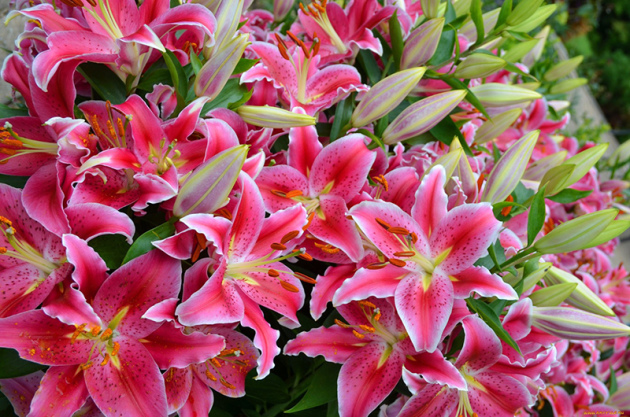
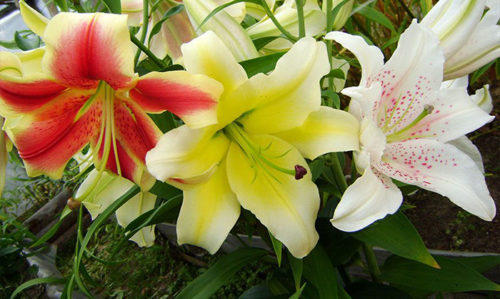
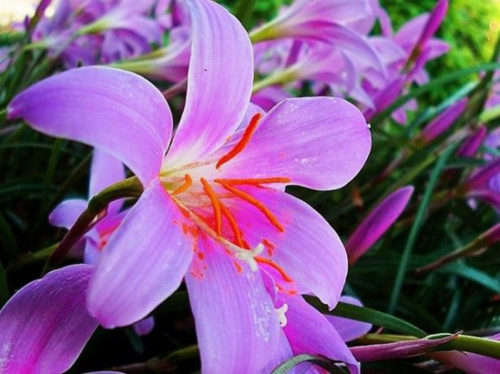
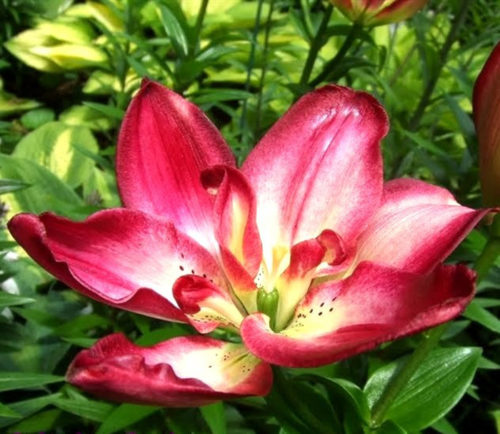
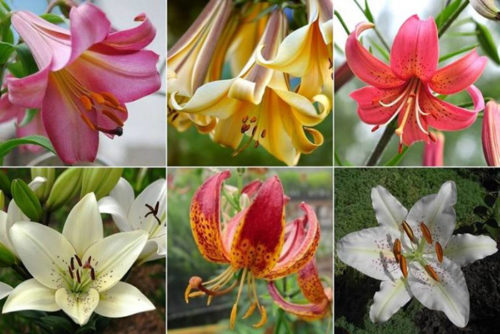
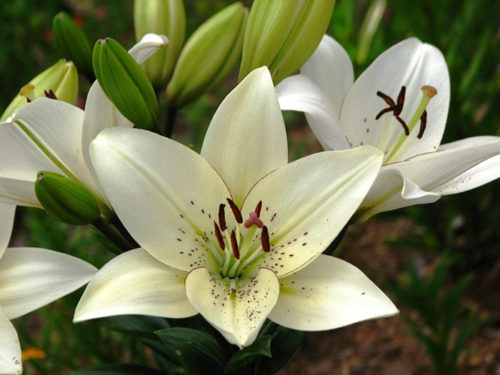
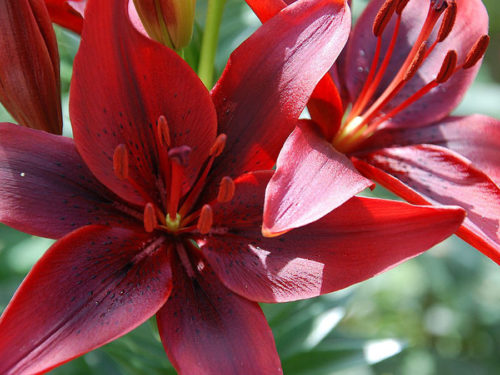
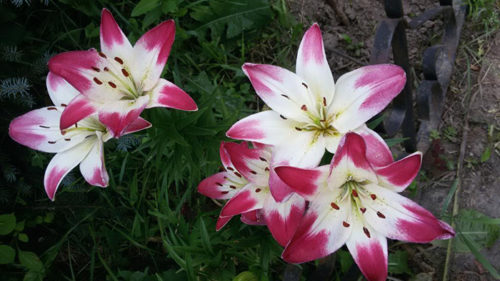
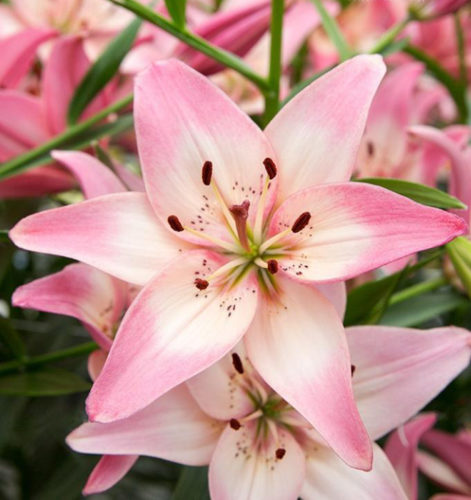
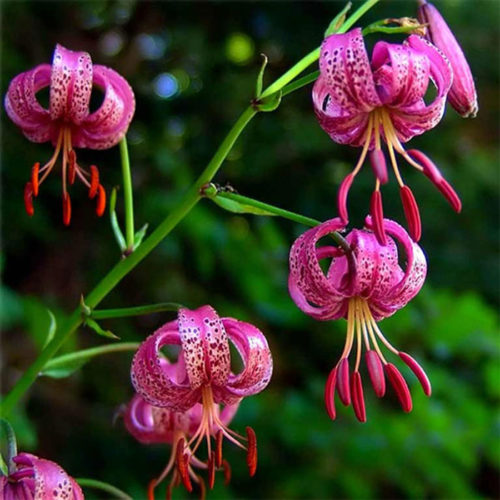
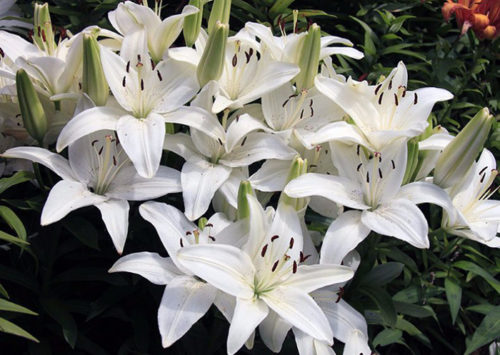

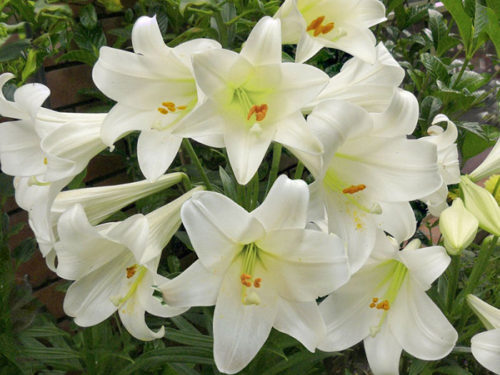
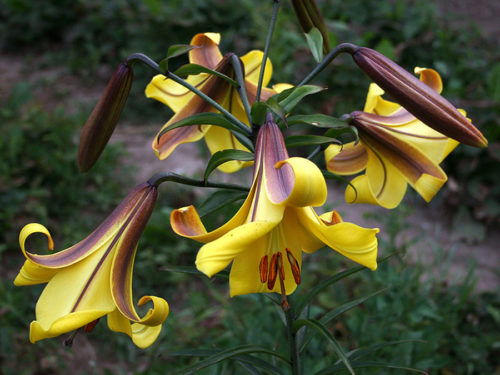
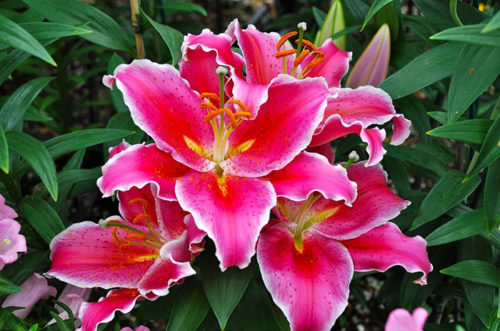
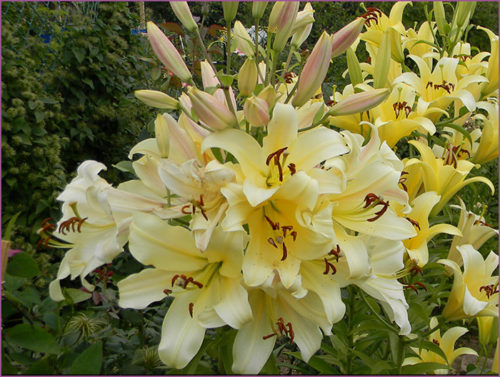
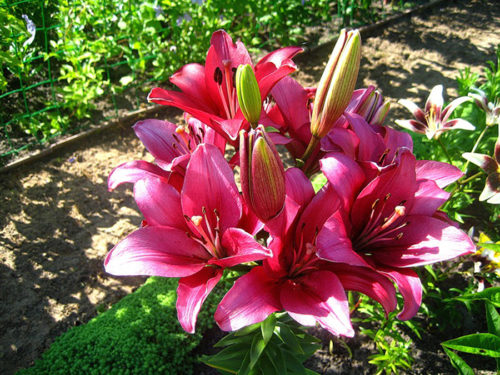
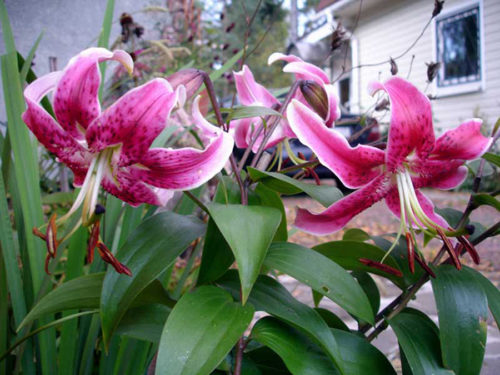

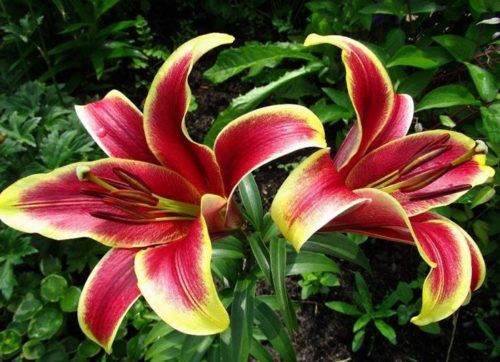
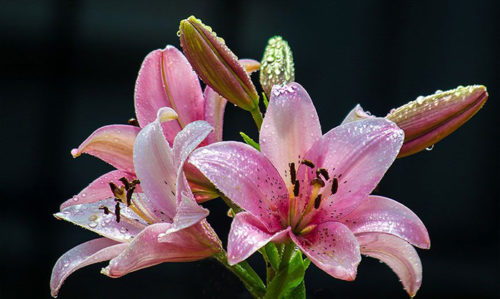
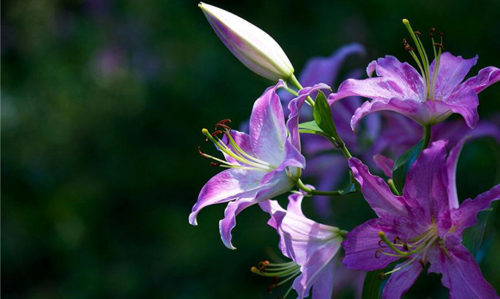
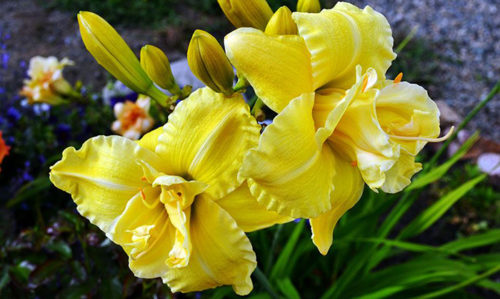

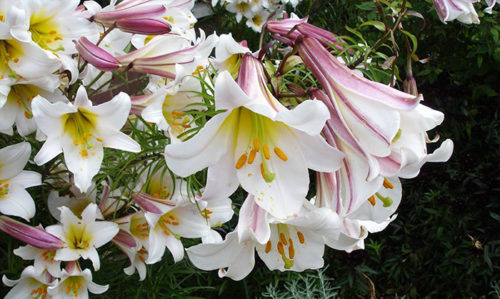












 Start a discussion ...
Start a discussion ...